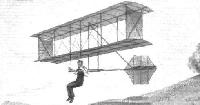A.Andrews. The Flying Machine: Its Evolution through the Ages (Putnam)
Octave Chanute, a French-born railway engineer domiciled in (though not confining himself to) the United States, who was 64 years of age when he tested by proxy his most significant biplane hang-glider in 1896.
Chanute had made himself the encyclopedist of aeronautics. The cream of what every designer needed to know lapped through the pages of his classic compilation Progress in Flying Machines, published in 1894. In 1900 Chanute met the Wright brothers, at their request, and he became their stimulator, sounding-board and propagandist. His inspiration was in the sphere of morale rather than practical innovation. The only physical features the Wrights took over from him in their machines were the secure trussed bracing of their biplane wings and the seed of their method of assisted take-off. But Chanute took the configuration of the Lilienthal-type biplane glider as far as it could go before moving control surfaces were introduced by the Wrights.
Журнал Flight
Flight, July 5, 1913.
THE PIONEERS.
<...>
Instead, it was in America that the influence of Lilienthal's work took permanent root. Octave Chanute, a distinguished American engineer, but already an old man, was intensely interested in the prospect of flight, and extended his practical patronage to the early movement by financing an important series of experiments in which the central figure was the well-known pilot, A. M. Herring.
It was while reading the simple notice of Lilienthal's fatal accident that Wilbur Wright received his inspiration to study this branch of practical science, and from the first he obtained the whole-hearted co-operation of his brother, Orville. The story of their work has been told too often to need repeating. Lilienthal died in 1896, and thereupon the Wrights commenced their studies. They built their first glider in 1900; it was a biplane, constructed on the trussed-bridge principle introduced by Chanute, but it differed from the Chanute machine in several important respects. Among other things, it embodied the famous wing-warping control, and the pilot, being thereby relieved of the necessity for balancing the aeroplane by gymnastic exercise, was able to lie prone on the lower plane, and so reduce the resistance of his body to a minimum.
<...>




